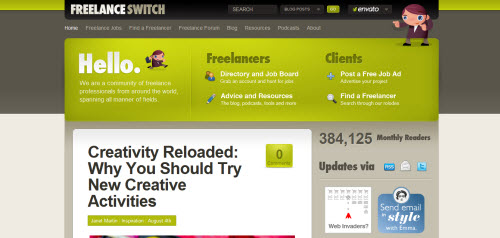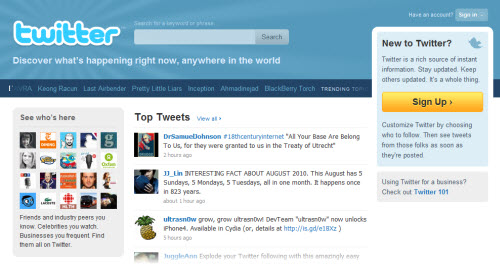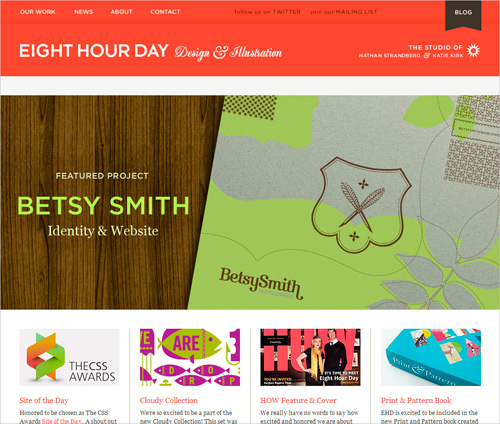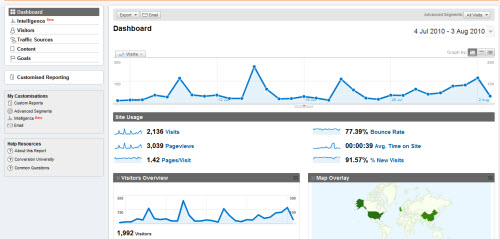The User Is The Anonymous Web Designer
We invest time, money and effort into understanding our audience, and the movement toward a more socially networked Web has made us realize the power that visitors have over how our designs are engineered; and we try to meet their ever-growing needs. Community is integral to the evolution and functioning of a website, and visitors and website owners have become dependent on each other. This reflects a change in the industry: the user has turned into an anonymous designer.
Further Reading on SmashingMag:
- Does The Future Of The Internet Have Room For Web Designers?
- Social Influence: Incorporating Social Identity Theory Into Design
- Social Media Is A Part Of The User Experience
This article will explore the influential figure ‘user’ and uncover the power of your community. Whether you boast social applications, interactivity or a stream of regular visitors, your audience might be a powerful untapped resource at your fingertips. You, the website owner, have the power to make decisions and override them (for better or worse), but the user deserves to be recognized as more than a statistic.
Traditional Roles
Back in the Web’s infancy, the roles of the Web professional and visitor were clearly laid out. Technologies such as email, bulletin boards and Internet Relay Chat (IRC) rooms existed, but most Web users were technologically inclined — cost and complexity of computers and Internet access were the biggest obstacles for many in the early days. Additionally, website were simple and the power of users was restricted; users had little sway with designers and developers.
The Professionals
The role of the Web professional used to be — famously, in the ’90s — to build websites that delivered certain information. Asking the user for feedback was an afterthought; this was evidence of the commonly held belief that we, the experts, knew what was best for users. Usability and accessibility were a luxury, and many website providers ignored them in an attempt to control the way the medium was used.

Historically, the Web professional’s role was to maintain websites.
The following were considered the primary tasks of the Web professional:
- Providing content and services to the client;
- Creating a website to hold the information;
- Dealing with technical requests about the information.
The Audience
Traditionally, the role of the audience was to give feedback, but it had — and still sometimes has — no influence on the website. The romanticized notion that a website owner should do whatever they want is to blame. In the past, a website’s popularity was determined mostly by content; marketing was restricted to directories and search engines; empowering the user and improving the feedback process was far from the designer’s mind.
The following were considered the primary tasks of the user:
- Give the owner financial incentive to continue offering the service.
- Popularize or endorse the website;
- Put the professional’s creation, free or not, to good use.
Those times have (mostly) come and gone. Without visitors, our websites would hardly exist, and when we realize that, we will abandon our old-fashioned ways and quit imposing our assumptions on users. Visitor interaction has become vital to the experience of a website, and the need for positive feedback — now visible everywhere and uncontrollable — has reversed the roles: our audience now has the voice and tools it needs to be satisfied.
Playing The Part
It has become important for us to define what roles the Web professional and user play in the dynamic process of building and improving websites, especially given the new-found focus on user experience and the development of tools that allow visitors to engage with and become attached to our services. Furthermore, ensuring that these roles are, in fact, played is essential to the process.
The Professionals
Professionals hold the keys to the castle. While many designers focus on the result, understanding what audiences need, what problems need swift solutions, which visitors require these solutions and how best to implement them is paramount. You might have some control over your users, but they can still dampen your popularity.

The user experience should actually serve the needs of users.
Here are some skills that professionals bring to the table:
- Knowledge of how to build a website and how it works;
- Experience with anticipating user needs;
- Delivering services and content that users need.
The Audience
Audience members play a different role. Most websites don’t offer a broad spectrum of customizable features (for good reason) or feedback options that give insight into how visitors use the website or what they’d like to see improved — specifically, what they’d like to see improved that would make them return on a regular basis. Word of mouth has become a serious force on the Web with Twitter, Facebook and their kin; and while you control the code, they control users’ wallets, attention and referrals.

Visitors know what they like, and negative feedback can spread quickly.
Here is what visitors contribute:
- Essential feedback on core service failings;
- Word-of-mouth promotion;
- Knowledge of what works, not just what’s pretty.
The roles of professional and user can be reversed on occasions when one expert helps another improve their website, resulting in a mixture of a professional perspective and visitor-oriented goals. Being both visitor and expert gives you empathy for the user and a valuable perspective, especially if you’re lucky enough to be in a position of power.
Nature Versus Nurture
Both sides bring goods to the table. Professionals bring the service and content into existence, thereby providing the “location for the party.” New visitors share vital details about how you can encourage them to be more involved, and they spread your website to the masses. Maintaining equilibrium between the professional and user is required if your Web presence is going to survive.
The Professionals
As it stands, the professional designer still plays the traditional role, but it should be expanded to encompass the evolving needs of our audience. The ability to nurture and cultivate is a skill ignored by many in our industry. In the past, “If you build it, they will come” described the Web fairly accurately, especially given the limited competition, but easy enterprise and designing for yourself have failed by their own merit.
Here are some problems that face a Web professional:
- Subjective opinion;
- Too many tasks to be able to master one;
- Fixated on success and reward (depending on the service being offered).
The Audience
Even if your visitor has no understanding of Web design, they will know what works for them, so you should encourage them to share their ideas. You can do this through code, design, experience and interactivity (or functionality). Playing to your audience’s strengths makes sense (if only to avoid the MySpace effect: going stale).
Some of the problems facing users are:
- Lacking knowledge of the Web’s limitations;
- Their diverse backgrounds and characters lead to quirks;
- Subjective opinions.
Survival of the fittest is the name of the game, and with the increasing pressure to focus on the needs of users and encourage them to connect to your services, it’s important that your designs are user-centric: contextual and interactive. The anonymous designer who knows what they want is well equipped for the Internet’s future. We can’t overlook users as we did in the past.
Elements Of Success
At this point, you’re probably wondering why we should place so much trust in users. That’s a fair question. Distinguishing between constructive advice and useless drivel can be difficult when many users don’t even know what a Web browser is, and determining the relevance of reviews is a challenge when manipulation is commonplace. All interaction with users should be done with respect (and perhaps a grain of salt), but it’s still worth encouraging the crowd to take action.
The trick is to use your knowledge (from statistics to semantics), experience, research and trust (of information sources) to your advantage.
By using a mixture of both quantitative data (numbers, statistics, etc.) and qualitative data (opinions, ideas, etc.), you can make informed decisions about what will work best for your clients. Putting the onus entirely on visitors is unfair, but giving them a channel for input will make a difference. If you don’t please them, they’ll surely take their business elsewhere.

The ABCs of experience: appreciation, balance and communication.
A few of the ideas you get from users are bound to be cringe-worthy, but it’s surprising how many good ones you’ll get if you implement feedback functionality properly. The stereotypical designer who leads with his gut is a testament to the lack of awareness of user expectations and needs. We must acknowledge this co-dependency, this need for an exchange of perspectives, and the value of the anonymous designer.
Appreciation
Your visitors are so much more than statistics. They deserve to be appreciated. You, the professional, can re-engineer a website until the cows come home, but it’s ultimately up to users to decide whether to make use of your services. Acknowledging and understanding their needs, and encouraging diversity, is critical to breaking down barriers.

Appreciate your users and the issues they might encounter, and be patient. That also means having a clean, attractive design that communicates. Example: EightHourDay
Ask your visitors the following questions:
- What, if anything, could my website offer to better meet your needs?
- Do you have any technical difficulties with the way the website functions?
- What more could we offer to deliver additional value?
Balance
Balance is integral to life, and it’s probably more critical to design than other Internet-related fields. Designers forge open bonds with visitors that often lead to social relationships that enrich not only our websites but our lives. Visitors hold greater value for our communities than many of us care to admit — think of Wikipedia or Facebook. Maintaining good relationships with them is paramount.

Stay level-headed by maintaining the balance between contribution and ownership.
Ask your visitors the following questions:
- How can we encourage you to participate more often?
- What content or services would you like to see in future?
- How much time do you spend on our website?
Communication
Communication is fundamental to our social and interactive experiences on the Web, and the staggering amount of rich content (not even counting spam!) that visitors contribute could exceed our wildest dreams. The user’s job is to come forth and help us help them, but our job is to act as intermediaries between them and the website so that they achieve the ideal experience. We are the Web’s “interpreters.”

Communication is paramount. Make sure you can be contacted easily.
Ask your visitors the following questions:
- Are we missing an essential feature that would help us help you?
- Do you have any concerns or complaints that we need to address?
- Is there anything you want to ask about our website or services?
The Sociological Switch
Of all that has been addressed in this article, the most important is the process of planning and implementing mechanisms for visitors to interact with your services. So, put time and effort into studying how to make your website better. There are many methods of doing this (audits, surveys, statistics). What’s important is that lines of communication with your users stay open, so that you can go about your business successfully.

Planning and research make up a huge portion of the creation of the user experience.
The future of the Web will be about being socially connected, and a role reversal that I call the “sociological switch” seems to be taking place. Simply put, we Web professionals are becoming the audience of our users’ demands, and users are becoming anonymous designers, deciding where they visit, how the Web should evolve and how media are constructed and consumed.
As you leave comments below, just think that by contributing here, you’re making a difference in Smashing Magazine’s relationship with its audience and the world. By leaving space for your comments and your participation, Smashing Magazine is trying to meet your needs. Think about how you can use your audience to your advantage and improve design beyond even your own expectations.






 Register!
Register! Flexible CMS. Headless & API 1st
Flexible CMS. Headless & API 1st

